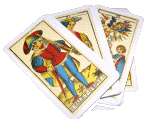
Bohemian Gothic Tarot
FIVE OF SWORDS
Lighter or more conventional meanings
A defeat * Feeling victorious at the expense of another * Winning a hard struggle * Aggression, picking a fight * A battle (which might be physical or emotional) that's unevenly matched * Picking on someone in a nasty way.
Darker, shadow or more hidden meanings
An unlikely struggle, the outcome might surprise you * A clash of two cultures * Intimidating or threatening someone, or being the victim of this * Being attracted to violence or physical power * The thrill of something wild and dangerous * A victim of abuse or violence "bites back".
The Five of Swords is usually one of the least welcome cards in a spread. It generally shows the end of a fight, with a victor watching two defeated enemies walking away dejected. It's about winning without honour, making gains at the expense of someone else, and it also refers to someone aggressive who is "up for a fight". In The Bohemian Gothic Tarot the scene is, at first, fairly consistent with this RWS meaning. We see a young woman sitting alone on a bench in the moonlight. Behind her is a picturesque castle perched on a great outcrop of rock. It's a beautiful scene, but hardly, one would have thought, a suitable place to sit alone at night.
However, she isn't alone. She turns to look at a monstrous figure looming over her. It's a werewolf or man-beast, bearing its teeth and growling. He may, in fact, already have lunged at her, for her sleeve is in tatters. It looks as though she's about to be torn to pieces.
But there is no blood to be seen. What's more surprising is that there is, it seems, no fear on her part. She holds her hand up to her heart in a coquettish manner and gazes at the wolf with an expression of thrill rather than terror. Could it be that she's excited by him? It's actually the wolf who looks rather hesitant and we wonder if he is realising that he's already defeated, his heart lost to this strange young woman. But there is also the possibility that she knows that his bite will turn her, too, into a werewolf. Is this what she desires and looks forward to?
When we read this card there are all sorts of ambiguities and questions to deal with. Who is the aggressor here and who the victim? The werewolf can be regarded as a symbol of deception, a man who hides the fact that he must become a wolf at the full moon. But the woman might also have been duplicitous. Just who is fooling who? Some of the answers may come from making a story of this card in a reading. We can imagine who this man and woman are, how they got to this moment and, most importantly, what happens next. In this way we can discern the right interpretation for any particular situation. But watch out! The Five of Swords is a tricky card which isn't always to be taken at face value.
Some further ways to consider this card
Try looking at the card in two contrasting ways; firstly, as if the werewolf is about to devour this young woman, secondly, as if she is the one who is taking control and will soon be telling the werewolf what to do. How might this change the way you interpret the card in a reading?
Ah! the mystery of those ensanguined fingers, those gory, wolfish jaws! that face, all besmeared with blackening blood, is revealed! The slain sheep, so mangled and rent - the fantastic butchery - the print of the naked foot all, all were explained;... I saw the wondering surprise in his haggard, bloodshot eyes; I saw him stare at me half vacantly, then with a crafty yet wondering look; and then I saw the devil of murder begin to peep forth from those hideous eyes, and the lips to part as in a sneer, and the wolfish teeth to bare themselves.
- Anonymous, "Horror: A True Tale" 'Stories by Modern American Authors.
THE WEREWOLF OR MAN-BEAST
WEREWOLF, n. A wolf that was once, or is sometimes, a man. All werewolves are of evil disposition, having assumed a bestial form to gratify a bestial appetite... Some Bavarian peasants having caught a wolf one evening, tied it to a post by the tail and went to bed. The next morning nothing was there! Greatly perplexed, they consulted the local priest, who told them that their captive was undoubtedly a werewolf and had resumed its human form during the night.
- Ambrose Bierce, The Devil's Dictionary.
The belief in shapeshifters, humans who can change into animals, is common throughout much of the world, but it's only the werewolf that's become a classic theme in Gothic fiction - probably because creatures like wererabbits and werebirds fail utterly to be so thrillingly dangerous. However, the "beast" of fairytale, a young man enchanted into a horrible monster that is large and fierce though of unspecified type, is a close parallel to the werewolf legend, and has many things in common with it. Through both, a strong vein of fascination and sexual attraction runs alongside the horror and perhaps it's this that's made both the man-beast and werewolf enduring themes.
The myth of Lycaon is the first known story of a werewolf. Lycaon invited Zeus to a feast and served him with a dish of human flesh. Appalled, Zeus refused to eat and instead turned Lycaon and his sons into wolves. In nearly all stories of werewolves since, the affliction is said to be either as a result of some awful transgression such as cannibalism, or an infliction caused by a curse. However, Sabine Baring-Gould in her 19th century Book of the Werewolf, gives a Russian spell for transforming oneself into an "oborot" or werewolf. Like many older Russian spells it involved singing or reciting an incantation:
"He who desires to become an oborot, let him seek in the forest a hewn-down tree; let him stab it with a small copper knife, and walk round the tree, repeating the following incantation: -
On the sea, on the ocean, on the island, on Bujan, On the empty pasture gleams the moon, on an ashstock lying In a green wood, in a gloomy vale. Toward the stock wandereth a shaggy wolf. Horned cattle seeking for his sharp white fangs; But the wolf enters not the forest, But the wolf dives not into the shadowy vale, Moon, moon, gold-horned moon, Cheek the flight of bullets, blunt the hunters' knives, Break the shepherds' cudgels, Cast wild fear upon all cattle, On men, on all creeping things, That they may not catch the grey wolf, That they may not rend his warm skin My word is binding, more binding than sleep, More binding than the promise of a hero!
"Then he springs thrice over the tree and runs into the forest, transformed into a wolf."
- Sabine Baring-Gould, The Book of Were-wolves.
In more recent Western tales the idea that it's the werewolf's bite that passes on this condition has gradually become an established theme. The influence of the full moon on the transformation is also now a firm part of the myth and it's generally believed that the afflicted man will only change into a wolf when the rays of the full moon hit him. The werewolf's tragedy is that he (and it is virtually always a male) has no control over the process. We are told that the vampire can change into a bat or a wolf and back again at will, but the man who carries the werewolf's curse in his veins is forced to become the beast whether he wants it or not.
While the werewolf has never become nearly as ubiquitous in popular culture as the vampire, it has had its place in some classic horror films. George Waggner's Wolf Man (1941) did much to establish the way that werewolves have tended to be portrayed in films ever since. Much of the mythology invented for it has since passed into popular culture and been taken, mistakenly, for ancient belief. John Landis' An American Werewolf in London (1981) took up Waggner's theme of the wolf-man who is to be pitied as much as feared. In an uneasy mix of horror and comedy he told a story that is by turns tragic and laughable. It's gone down in film history, however, for the excellence of its make-up and prosthetics techniques used in a transformation sequence that's still impressive. More recently we've seen films such as Mike Nichols' Wolf (1994) that are arguably less successful; it's interesting to note that the trend in these modern pieces is to make the werewolf into a noble hero rather than a savage beast.
Modern writers such as Angela Carter have taken up the theme in a more sexually knowing and morally enigmatic way. In her stories "The Company of Wolves" and "Wolf-Alice" she reinvented the transformation as something alluring, scandalous, yet, at the same time, lyrical. To Carter, the werewolf represents the overt wildness and physicality that girls were, in the past, repressed from expressing. In her stories, the girl who "runs with wolves" is much more unfettered and joyful than the one who obeys her granny and sticks to the paths of civilisation. Finally, it's worth mentioning recently one of the few were-beasts that is not a wolf and yet features in a fairly popular story. In a curious and rather outdated piece, Bram Stoker invents a character who is a beautiful aristocratic lady possessed by a giant white snake or "worm". Like the werewolf, her state is caused by a bite:
When still a young girl, Lady Arabella wandered into a small wood near her home, and did not return. She was found unconscious and in a high fever - the doctor said that she had received a poisonous bite, and the girl being at a delicate and critical age, the result was serious -so much so that she was not expected to recover. A great London physician came down but could do nothing - indeed, he said that the girl would not survive the night. All hope had been abandoned, when, to everyone's surprise, Lady Arabella made a sudden and startling recovery. Within a couple of days she was going about as usual! But to the horror of her people, she developed a terrible craving for cruelty, maiming and injuring birds and small animals - even killing them. This was put down to a nervous disturbance due to her age.
- Bram Stoker, The Lair of the White Worm.
The Lair of the White Worm was made into a wildly eccentric and often unintentionally humorous film by director Ken Russell, known for his occasionally fabulous but often kitschy style. In the end it may have been recently too difficult to create a were-snake that the audience did not find vaguely laughable. By the way, there is a curious link between this Bram Stoker novel and tarot; it was Pamela Colman Smith - the same artist who is famed for her work on the Rider Waite Smith tarot - who illustrated the 1911 Rider publication of The Lair of the White Worm.









